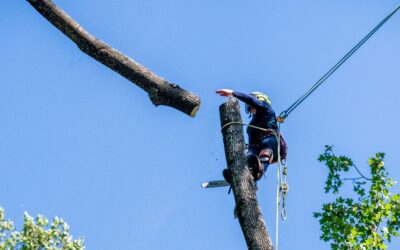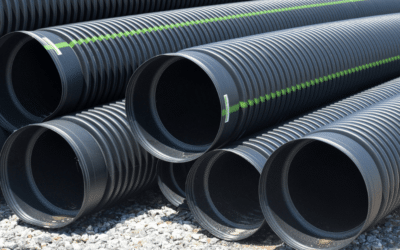Blog Topics
Summer in northern Virginia can be tough on lawns, especially when lawn watering isn’t done correctly. We’re often asked how to keep lawns in Fairfax and Loudoun counties looking their best despite the summer’s scorching heat and humidity. The answer is simple: one of the keys to maintaining a good-looking lawn is proper watering. However, lawn watering isn’t as simple as it seems. In this article, we discuss the proper way to water your lawn in summer as well as the things to avoid. Keep reading to find out:
- how to tell if your lawn doesn’t have enough water
- signs that indicate you’ve overwatered your lawn
- how to help a lawn recover from water stress (either too much or too little water)
- how much water lawns in Northern Virginia really need
- our top lawn watering recommendations that will ensure your lawn stays healthy throughout the summer months
What’s in Your Lawn?
Depending on what you choose, or what you inherited when you moved in, lawns can be made up of a single grass species or a mix of grasses. Additionally, lawn grasses are categorized as “warm season” (zoysiz and Bermudagrass as two examples) or “cool season” (such as tall fescue and Kentucky bluegrass) depending on the conditions in which they grow best.
These differences can explain why your lawn might conk out during a heatwave. A cool season grass can go dormant in very hot weather, while warm season lawns will close up shop when temperatures drop. It’s good to understand what your grasses are so that you don’t treat a lawn problem that’s actually natural (and expected) dormancy.
So, what kind of grass is best for your northern Virginia lawn? Check out this publication from the Fairfax County Master Gardeners that has descriptions of common lawn grasses that grow well in northern Virginia.
Summer Lawn Watering: What to Watch Out For
Signs of an Underwatered Lawn
Chronic underwatering during hot weather will keep your lawn in a constant state of water stress, and cool-season lawns may go dormant. Here are signs that mean your lawn isn’t getting enough water:
Dry soil
This sounds obvious but it’s not always easy to tell if the soil beneath your turf is too dry. The simplest method is to use the “Screwdriver Test”. Grab a screwdriver with a long blade and try to poke it into the soil. If you can drive the whole thing (or most of it) into the ground, your soil is moist enough. If you can’t, or can only push it in an inch or two, your soil is too dry.
Shallow roots
Grass develops shallow roots if it doesn’t get enough water or gets frequent but very shallow irrigation. That makes the turf even more susceptible to heat and water stress. Healthy grass roots should reach about 4 or more inches into the soil. Dig up a small patch of lawn and see how long the roots are. If they’re all near the soil surface, you’re not watering enough.
Grass doesn’t spring back
When you walk across the lawn, how long does it take the grass to stand back upright? If you can still see your footprints after a minute or so, your lawn needs more water.
Yellowing turf
Dry soil doesn’t provide the nutrients turfgrass needs to stay lush and green. Plus, beneficial microbes start to die without enough water. You’ll notice grass blades starting to yellow, growth slowing down, smaller blades, and eventually, dying grass.
Wilting
Like most plants, turfgrass wilts when it doesn’t have enough water to maintain an upright position. This is a natural response and one that you can avoid by giving your lawn the water it needs. Let your lawn stay wilted for too long and it will start to die…
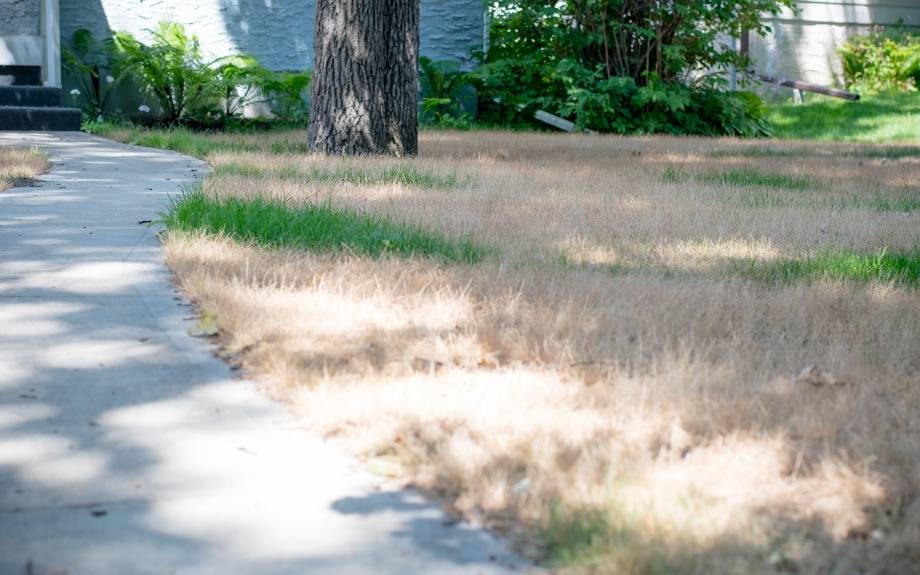
Lawns that don’t receive enough water in summer, or don’t get enough water across the entire lawn area, will die or go dormant during the hot, dry weather.
Saving an Underwatered Lawn
The good news is that a dormant cool-season lawn will regrow after water stress. On the other hand, a dead lawn won’t. That’s one reason why it’s important to know what kind of turfgrass your lawn is composed of.
If your lawn regularly shows signs of water stress, a few simple changes can help it spring back. Those include:
- Consistent, even irrigation that reaches the roots (a 10-minute sprinkle isn’t likely to penetrate deep enough)
- Regular fertilization (without going overboard)
- A good mowing schedule that keeps turfgrass tall enough to shade its roots (not too much at once and not too short)
Signs of an Overwatered Lawn
Overwatering the lawn is more common than you may think. If you have well-draining soil and an even cross-slope, your lawn can put up with some overwatering without incident. But don’t make the mistake of thinking that “if some water is good, more must be better”.
Excessive lawn watering invites a whole set of problems that will make your lawn look terrible. Common signs of excessive lawn watering include:
Fungal diseases
Fungus loves warm, wet soil and grass blades, and will thrive in overwatered lawns. You may see mushrooms, mold, blight, and even algae in an overwatered lawn. Because symptoms of overwatering are often mistaken for water stress (lack of water), many people end up watering even more when fungal diseases take hold, compounding the problem.
A yellowing, wilting lawn
Too much watering leads to saturated soils and low soil oxygen levels. Your lawn can drown when there’s no oxygen available for grass roots, turning it pale green/yellow and making it wilt (it looks very much the same as grass that isn’t getting enough water). It’s better for your lawn to get a little dry than to be too wet.
Muddy, compacted, rutted soil
Saturated soil turns into mud. This will compact when stepped on, further reducing oxygen available to the grass. Mud and soggy soil will also slip out of place under the weight of feet and machinery, making ruts and ripping out grass roots as it goes.
Thatch buildup
Thatch is made up of dead grass blades that haven’t yet broken down. It’s generally not a problem in a healthy lawn. However, too much moisture slows down decomposition, leading to a thick, impenetrable layer of thatch. When water and nutrients can’t reach grass roots, the plants start to die. Plus, excessive thatch attracts insect pests, like chinch bugs, that further damage your lawn.
Lots of weeds
Some of the more noxious weeds in northern Virginia, such as nutsedge and ground ivy, love water and hot weather. An overwatered lawn creates a perfect environment for weeds to grow quickly in summer, crowding and shading out your lawn.
Runoff
If you see water flowing off your lawn, it’s a surefire sign that your lawn is oversaturated. The runoff is also likely to be taking fertilizer and/or lawn treatment chemicals with it, washing them into the storm sewer and our water supply.
A note about runoff: Fairfax and Loudoun counties understand the seriousness of fertilizer runoff, and need your help in preventing it. It’s all our responsibilities to keep our waterways and our aquatic life healthy, and to prevent waste wherever we can. You can have a healthy, green lawn without contributing to runoff—just ask us!
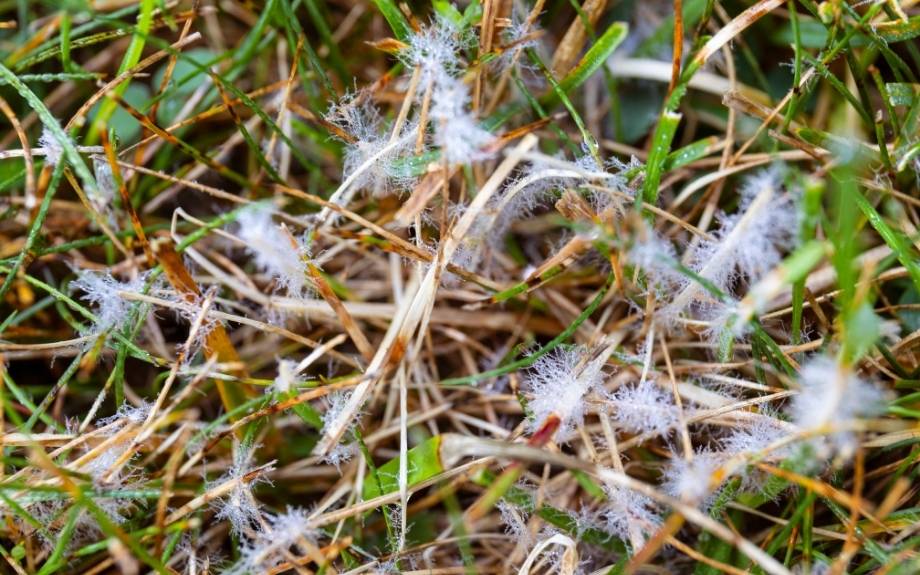
Fungal problems, such as dollar spot, are common on overwatered lawns.
Saving an Overwatered Lawn
It’s important to remember that water stress can result from both over-and underwatering. So, before you turn up the irrigation, check your lawn’s moisture level.
The root system of the average lawn grows to a depth of around four inches, and it can become waterlogged as well as dry. Make sure your irrigation system is running on a cycle that:
- Gives your grass enough moisture each week, relative to changing temperatures (as temperatures heat up, your lawn will need more water),
- Does not cause runoff during a cycle by spraying more water than the soil can absorb, and
- Is not over-saturating the soil and “drowning” the lawn’s roots.
For details on how to recognize and deal with other summer lawn problems, see our article on lawn problems in northern Virginia.
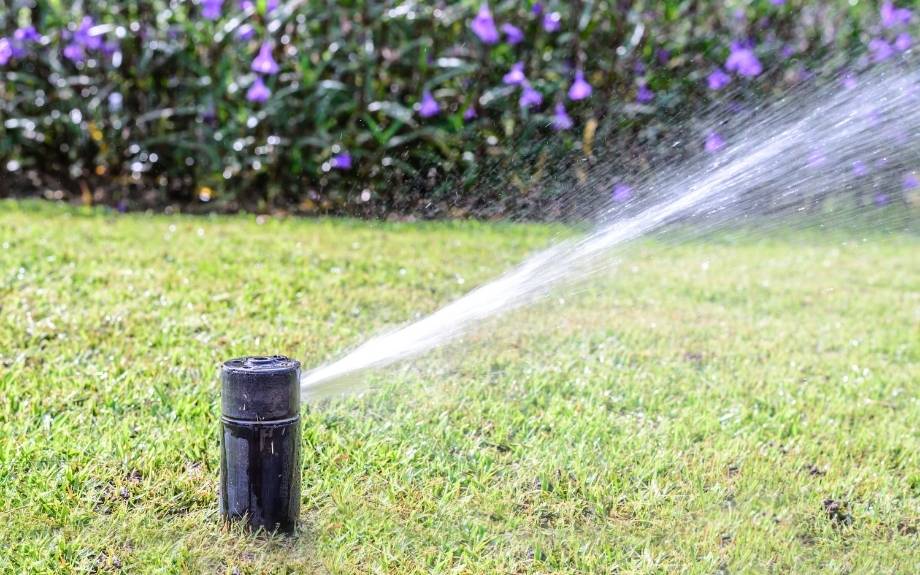
How to Properly Water Your Lawn in Summer
First, make sure that you’re following all local regulations for watering lawns. Some regulate the day, others the frequency; be sure that you’re following the rules.
Then, follow our recommendations below that should help keep your lawn and landscape healthy during the summer heat.
Does the lawn really need water?
Always check the ground moisture before watering your lawn. Don’t just rely on conditions at the surface to determine whether or not your lawn needs water. Instead, use a probe to check deeper into the ground. Soil should be damp 6-12” below the surface to encourage a deeper (and more drought-resistant) root system for your turfgrass.
Understand how much water your turfgrass needs
Different types of turfgrass, sun exposure, temperature, and soil conditions require different amounts of water. In general, lawn grasses need 1 to 1.5 inches of water per week. Because it’s difficult to apply all of that water at once without excessive runoff, we recommend watering two or three times per week. Aim to provide about ½” of water over the course of an hour to prevent runoff. Give your lawn enough water each time to add up to the right amount over the course of the week.
How do you know how much water you’ve given your lawn? Place several small cans (tuna cans are the perfect size) around your lawn and run your irrigation system or sprinkler. When the can has ½” of water it in, that means the surrounding lawn has gotten the same amount.
Adjust your lawn watering schedule
Timing is important when watering your lawn. The best time to water your lawn is early in the morning – really early! Between 4 AM and 7 AM is optimal. If you water during the day, sun and heat will evaporate 20-25% of the water, leaving much less water for your grass. To help with this watering schedule, use a timer on a sprinkler or irrigation system. It’s much better than waking up at two in the morning!
You may notice that some people water their lawn every day, sometimes for as little as 10 minutes at a time. Please don’t do this! Like most plants, turfgrass does best with infrequent, deep watering that encourages it to grow deeper, stronger roots. Shallow, frequent watering leads to shallow roots that make the plant wilt, and even die, during hot, dry weather.
Do not water the lawn at night
Water doesn’t evaporate as much during the nighttime hours. Turfgrass that stays wet throughout the night can develop fungal problems and root rot.
Do not water when it rains
That might sound simple but if your irrigation system operates on a set schedule, you could find yourself overwatering your lawn. Use a rain sensor or weather shut-off to stop irrigation if there’s been enough rain already. Some smart irrigation controllers check the weather forecast and adjust the watering schedule for you! Irrigation specialists can also install a rain sensor for your automatic system to detect moisture and prevent overwatering.
Keep Your Lawn Looking Great This Summer
Riverbend Landscapes can help you implement these lawn care tips, in addition to any of your landscape design, installation, or maintenance needs. We provide routine mowing, landscape upkeep, irrigation checks, and more, allowing you to focus on enjoying your landscape rather than working in it.
Call us today (or use our handy online contact form) to find out more about our northern Virginia lawn and landscape services.
Give Us a Call at 703-402-9366
If you'd like help with your trees or landscape, have any questions, or would like to schedule an appointment with one of our Certified Arborists, please give us a call. We'd love to hear from you!

